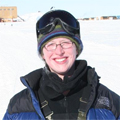The Clock is Ticking
I looked up at the weather screen today and saw that the temperature had dropped to -38 F (which is actually almost exactly equal to -38 degrees C). The windchill today is about -60F. The dropping temperatures signal that the end of the season is rapidly approaching. Soon, it will be too cold for planes to land here, and the station will be isolated for a period of 8 months. Most of the South Pole Telescope team is scheduled to leave on one of the last two flights out, expected to be on February 14 or thereabouts. As the end of the summer season approaches, personel on station are changing over as the summer staff leaves and the winter staff arrives. Rumors are flying about the station closing early, and about whether enough food and fuel have been delivered to sustain the station over the long winter. I think those rumors are as much a part of this season as the daily drops in temperature.
For SPT, this is a tense few weeks. We have just installed a brand new set of detectors in the receiver. These are much more sensitive than the ones that we used last season, but every new batch of detectors made at Berkeley is different, and it takes a lot of work to understand their features. We have a very short time to get the new receiver working, characterize the detectors, put everything in the telescope back together again, and get it all to work together. In the midst of this, we have two new members of the collaboration (Keith Vanderlinde and Dana Hrubes) who will be operating the instrument over the winter. They both need to be trained, and are understandably anxious about learning enough in such a short time to handle everything that could go wrong once the rest of us leave. I am not personally involved in much of the receiver work, but the tension permeates everything that we are currently doing.

This is a close-up picture of a set of detectors like those we just installed. Each little circular element is a few millimeters across, and is an ultra-sensitive radiation detector. The full array that makes up our focal plane consists of hundreds of these.
The detectors are fabricated on wedge-shaped wafers and then carefully installed in a ‘wedding cake’ assembly with optical feeds above each detector and a triangular filter above each wedge. The filters ensure that the radiation that reaches the detectors is the right frequency. The process of assembling and installing the focal plane is one of the most delicate tasks on this project. It’s taking place right now as I write this entry, and if everything goes well we’re on our way to a beautiful, sensitive new detector array for the second season of the SPT.

The “wedding cake”, aka rebuilt receiver.

 No comments
No comments 







